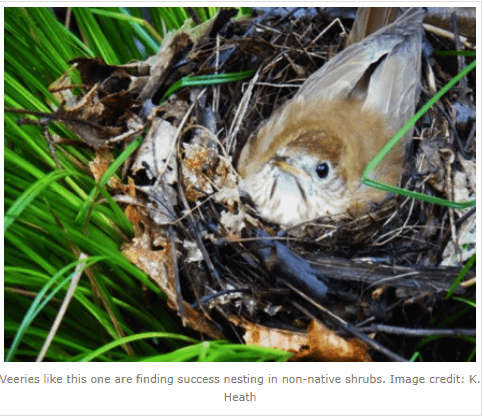(June 10, 2015, The Condor: Ornithological Applications)—We all like things that are bad for us sometimes, and birds are no different. When a bird or other animal makes choices that are actually harmful for it, by reducing their lifespan, reproductive success, or something else, this is known as an “evolutionary trap.” If birds prefer to build their nests in non-native plant species but these nests are less successful, they’ve fallen into such a trap. A group of researchers recently set out to determine whether this is the case for Veeries (Catharus fuscescens) nesting in invasive shrubs in the forests of New York.
Lydia Meyer and Bruce Robertson of Bard College, along with Kenneth Schmidt of Texas Tech University, monitored 84 Veery nests during the spring 2013 breeding season in a forest where invasive shrubs such as Japanese honeysuckle, barberry, and multiflora rose are abundant. They recorded a variety of characteristics related to nests’ location, including nest height and visibility, the type of plant a nest was placed in, and the type of vegetation within a 5-meter radius around the nest. Their results, published this week in The Condor: Ornithological Applications, show that while these Veeries did prefer to locate their nests in non-native plants, this choice didn’t hurt their nesting success at all.
“While it is disappointing that exotic understory plants are displacing their native counterparts in forests throughout the Northeastern U.S., it is encouraging to see that at least one native bird is able to find that these exotic replacements also make safe locations to place a nest,” says study author Bruce Robertson. The Veeries’ choice to nest in non-native shrubs wasn’t bad for them after all—instead, they were just taking advantage of a new suitable habitat.
“Meyer et al. provide a critical test of whether non-native plant species can act as ecological traps for nesting birds. Nest site preferences in birds evolve over time based upon nest survival rates in different habitats, and may be confounded by the novel cues introduced by non-native plants,” adds Anna Chalfoun of the University of Wyoming, an expert on wildlife–habitat relationships. “Interestingly, in the example of the Veery, Meyer et al. conclude that parents were able to exploit the novel nesting sites provided by non-native plants, with no apparent effects on the probability of nest survival.”

About the journal: The Condor: Ornithological Applications is a peer-reviewed, international journal of ornithology. The journal began in 1899 as the journal of the Cooper Ornithological Club, a group of ornithologists in California that became the Cooper Ornithological Society.